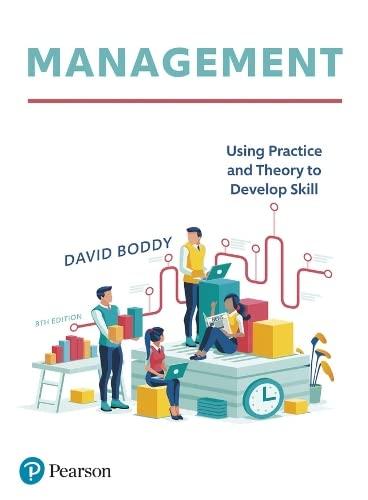Question
SELECTED PARAGRAPHS OF THIS ARTICLE RE: NON-ECONOMIC WORK RULES Reforming the U.S. system of collective bargaining Collective bargaining procedures and relationships between labor and management
SELECTED PARAGRAPHS OF THIS ARTICLE RE: NON-ECONOMIC WORK RULES"
Reforming the U.S. system of collective bargaining Collective bargaining procedures and relationships between labor and management must reflect less conflict, more cooperation as the Nation's economy struggles to meet international competition and domestic needs D. QUINN MILLS Rules as a productivity drain Rules alone cannot ensure that an organization will perform well. They may keep it from dissolving into self-defeating open warfare, but often do not permit it to achieve its potential.An organization which depends upon adherence to a myriad of rules will always be vulnerable to competition from other organizations which operate in a more consensual and cooperative fashion,even when the latter have fewer resources. And, although an organization of rules may sometimes pull it-self together to respond to an emergency, this need not necessarily occur. It follows, then, that primary dependence on establishing and enforcing rules is a very poor way to run an economic enterprise.The existence of a multitude of rules, many of which attempt to "stretch the work" to maintain jobs in ways reminiscent of depression-era tactics, constrains productivity and raises costs.For example, maintenance classifications may prohibit an employee from doing incidental work outside the strict limits of his or her trade; multiple job classifications may exist even where a person in a single combined classification could do the work effectively, without undue effort and stress; and, job classifications may be perpetuated although technological change has rendered the incumbents' work trivial. Other restrictions may limit the amount of work a person may be assigned, such as permitting a mechanic to open only two flanges. The location of materials and inventory may be restricted by contract or past practice to retain jobs in now-inefficient areas of the plant. In some cases, rules may prohibit employees being assigned work during breaks, and simultaneously prohibit supervisors from doing the employees' work, so that emergencies occurring at coffee breaks or lunchtime cannot be legally handled under the agreement. Over time, rules tend to become increasingly costly and constraining as technology, materials, products, and other aspects of production change. Even rules which made great sense at first become out-of-date under changing conditions. But the rules are difficult to change, and particular employees may be further benefited the more outdated the rules become. Sometimes a company can pay a high price and "buy the rules out," or a union can persuade some workers to give up favored positions for the good of the membership as a group. But often, change cannot be accomplished without a bitter struggle between management and labor.Furthermore, the rule making process promotes a set of attitudes which are inimical to successful enterprise. The existence of the rulebook encourages both management and labor to assert their rights under the contract, rather than to attempt to work out problems. It gives rise to "shop-floor lawyers," rather than problem solvers. It fosters conflict and controversy. It undermines trust. To a large degree, it seems that unions have become captives of their origins. Born in adversity and conflict, they continued to act as opponents of management even when their strength had become much greater. In some instances, unions have created thickets of rules in which to immobilize management, just as spiders build webs to ensnare prey. But when the thickets of rules have crippled productivity, the unions have discovered themselves to be caught alongside management in the trap. Plants have declined in competitiveness, and jobs have been lost. The unions have discovered too late that a snare is no less a snare because they have set it themselves. A prescription for change In a recent survey conducted by the Harris organization, a majority of the general public professed the belief that unions contribute less than they once did to the growth and efficiency of business. Not surprisingly, only 15 percent of union leaders agreed with this judgment.' The need for unions to assist companies in the light of increased foreign competition is apparent to the public. To the inhabitants of the Snow Belt, it is similarly evident that unions should cooperate with local business to stem the outflow of industry and jobs to the South and West. Public perceptions of a productivity problem are supported by Bureau of Labor Statistics estimates, which show particularly sluggish growth in output per labor hour after 1973.3 Collective bargaining practiced primarily as rule making has become self-defeating for both unions and management.It interferes with management's efficient operation of the enterprise, and ensnares employees with legitimate grievances in a web of red tape. It also contributes to the vehemence of employer attempts to resist union organization drives.Study after study of U.S. managers has shown that managers fear the imposition of restrictive work practices far more than the higher wages and benefits which unionization may bring.Companies' efforts to make competitive operations out of older plants often fail because changes in current work rules take the form of additional complex rules which do not provide the flexibility needed to turn a facility around. What management really needs is fewer rules altogether, and willing cooperation from the work force. The union, for its side, needs a management sensitive to the needs of people. Both are very difficult to obtain in the U.S. labor relations environment.
As early in the week as possible, please enter into a dialogue with me and your classmates on D. Quinn Mill's writings about work rules and restrictive work practices, above.
Step by Step Solution
There are 3 Steps involved in it
Step: 1

Get Instant Access to Expert-Tailored Solutions
See step-by-step solutions with expert insights and AI powered tools for academic success
Step: 2

Step: 3

Ace Your Homework with AI
Get the answers you need in no time with our AI-driven, step-by-step assistance
Get Started


